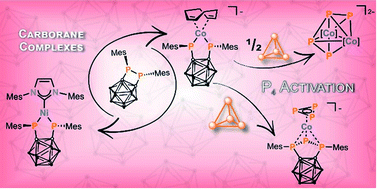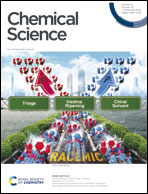Synthesis of a carborane-substituted bis(phosphanido) cobaltate(i), ligand substitution, and unusual P4 fragmentation†
Abstract
Oxidative addition of the P–P single bond of an ortho-carborane-derived 1,2-diphosphetane (1,2-C2(PMes)2B10H10) (Mes = 2,4,6-Me3C6H2) to cobalt(−I) and nickel(0) sources affords the first heteroleptic complexes of a carborane-bridged bis(phosphanido) ligand. The complexes also incorporate labile ligands suitable for further functionalisation. Thus, the cobalt(I) complex [K([18]crown-6)][Co{1,2-(PMes)2C2B10H10}(cod)] (cod = 1,5-cyclooctadiene) bearing a labile cyclooctadiene ligand undergoes facile ligand exchange reactions with isonitriles and tert-butyl phosphaalkyne with retention of the bis(phosphanido) ligand. However, in the reaction with one equivalent of P4, the electron-rich bis(phosphanido) moiety abstracts a single phosphorus atom with formation of a new P3 chain, while the remaining three P atoms derived from P4 form an η3-coordinating cyclo-P3 ligand. In contrast, when the same reaction is performed with two equivalents of the cobalt(I) complex, a dinuclear product is formed which features an unusual P4 chain in its molecular structure.



 Please wait while we load your content...
Please wait while we load your content...